A Zero Irrigation Garden
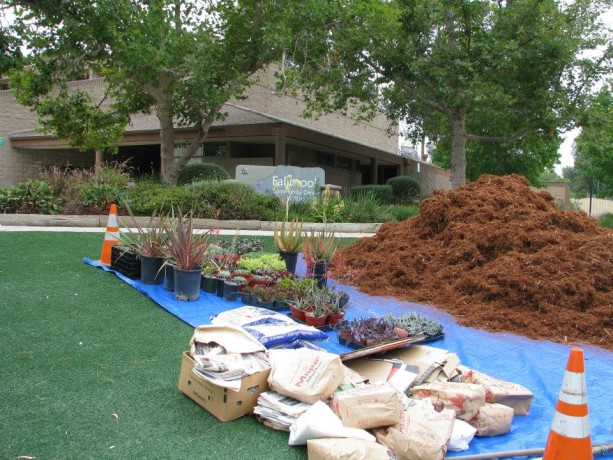
In response to the water cutbacks, the County of San Diego Dept. of Parks and Recreation deemed it necessary to turn off irrigation to the front two planting beds of the Fallbrook Community Center. The plan was to tear out the plants and replace them with decomposed granite and a bench.
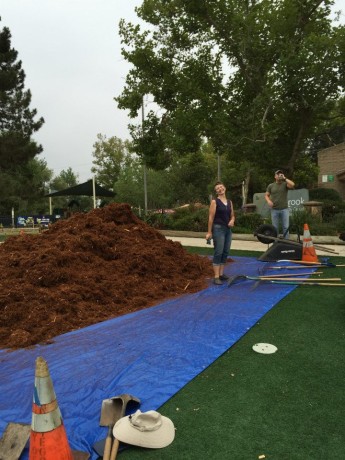
Health and fitness instructor Ann Wade, also the president of the Friends of the Fallbrook Community Center, contacted me and I came up with a design using native plants and a variety of succulents that could survive without irrigation. More than that, simple earthworks in the form of swales and small rain catchment basins could be dug to hold run-off, and sheet mulch applied to retain moisture. The plan was accepted and several weeks ago we had a planting.
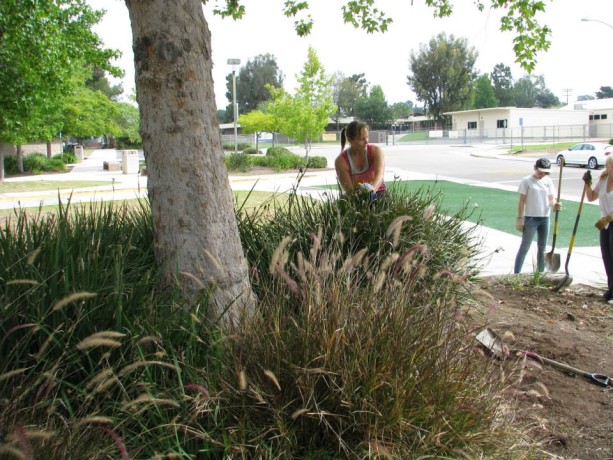
A big portion of the planting was to remove the existing plants that would have died anyway. These plants had been haphazardly installed, and apparently most were leftovers from a long-ago Fallbrook Garden Club plant sale.
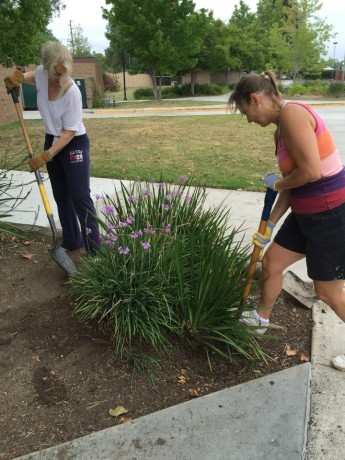
The Community Center sign was partially blocked, sea lavender had to be cut practically in half to keep it out of the pathway, and some bushes had to constantly shaped. As much as I dislike removing plants, they had to go.
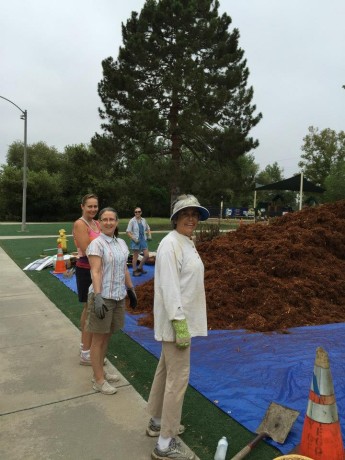
On a hot summer’s day many wonderful friends of mine and my daughter arrived to do permaculture at the Community Center. A good portion of the morning was spent hacking out the existing plants.
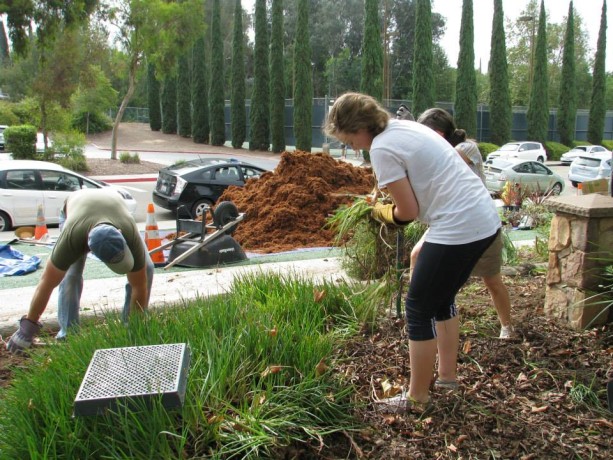
The ground was so hard from years of spray irrigation and rainwater runoff that these plants had to be chopped rather than dug. The roots had formed a solid mat close to the surface in their desperate search for water.
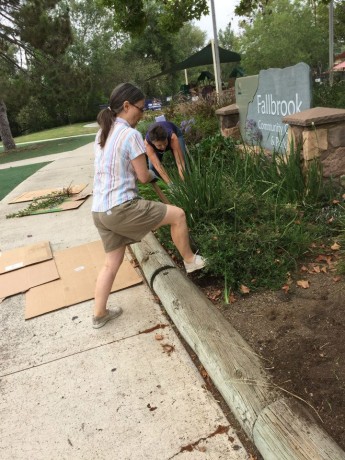
The irrigation had been run the night before, but very little of this water was evident, and some of it showed evidence that it simply ran off. This removal process took much longer than I had anticipated, but after the slaughter we were able to move ahead.
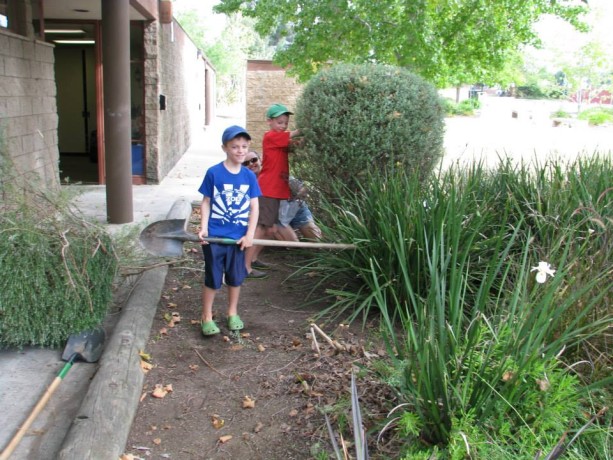
I dug shallow swales perpendicular to the flow of rainwater from the sidewalk and roof, you can see this for reference. Dug is not the best word here; chopped would be better as the soil was so hard. I also dug some shallow basins around the planting beds, making the soil surface uneven to collect rainwater.
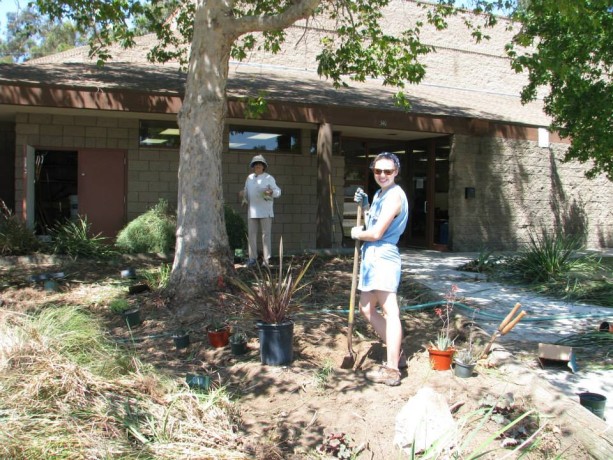
Each bed sports an old beautiful California sycamore, a riparian tree, and with the reduction of lawn irrigation and termination of irrigation in the beds (however unhelpful that was), these trees could be imperiled. The swales – shallow ditches with level bottoms- would allow rainwater to percolate into the soil and travel deeply to the roots rather than run over the top. Small swales above plants are key to holding rainwater in the soil and preventing flooding and topsoil erosion. Swales are how we can recharge our subterranean waterways, refortify our wells and reestablish summer streambeds.
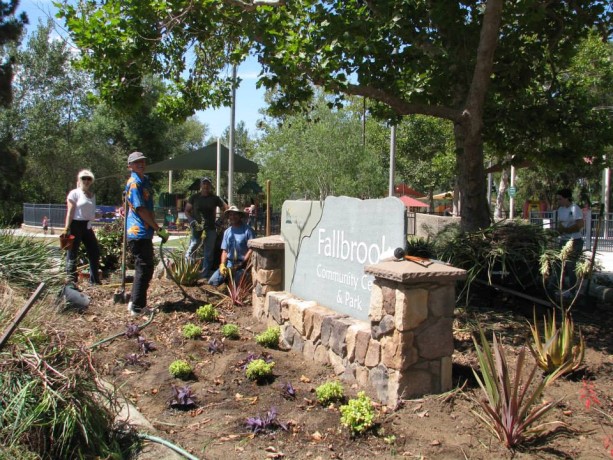
We had ordered four boulders as well, and these were placed to focus the eye on the sign and the plants rather than the back wall of the Community Center, and to tie in with the stone base of the sign. This sounds easier than it was. To look natural, boulders should be buried 1/4 to 1/2 way into the ground. I’m not sure which was more difficult for the volunteers: to dig a hole in that hard dirt or to move the boulders uphill and into position. Fortunately no fingers or toes were lost and the boulders looked great. They were chosen to be pointy so as not to entice children to sit or stand on them.
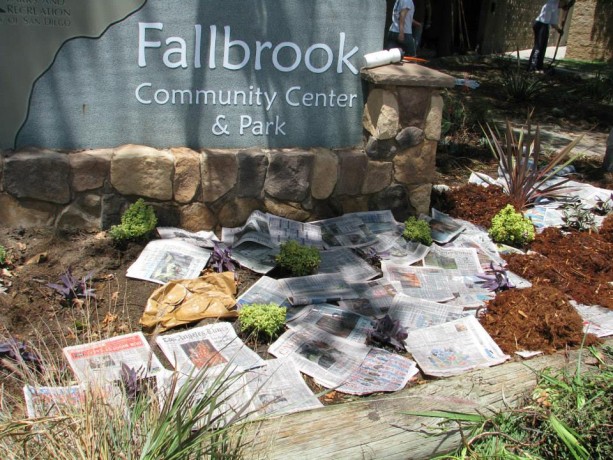
After placing a selection of California natives appropriate for the shade, part sun and full sun areas, and placing the succulents, we sprinkled a little composted chicken manure over the soil surface and the team placed sheet mulch around the planted plants. Sheet mulch is another inexpensive miracle that can save so much water and improve plant growth in our dry climate.
This manure would help feed microbes as they began to populate the area. On top of that was spread cardboard, newspapers, and leftover freebie magazines (with the glossy cover discarded). We were repurposing trash from the community center back into the planting beds! How cool is that? For native plants, this layer didn’t need to be thick because it was to help nursery in the new plants, suppress weeds, hold in moisture during our hot months, and act as soil protector from rainfall.
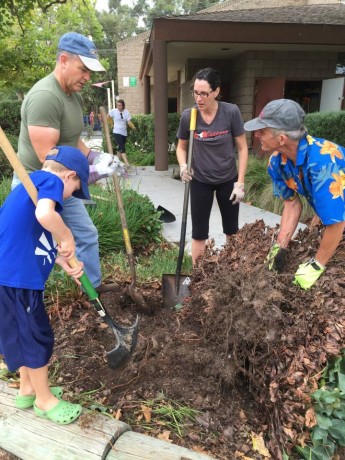
Rain on bare earth is more compacting than driving a truck over the ground. For thirstier plants such as non-natives, thicker layers of cardboard should be added. As a guide, think of what the plant in question at maturity might have around its base for mulch. An avocado tree would have a very thick layer of leaves and fruit. Avocados and citrus don’t like anything growing around their roots, so they block the sun with their foliage and cover the ground with debris. By adding 1/2″ to 1″ or more cardboard around these trees and those plants that require more moisture, you save a lot of water and give the plant what they need to live and produce without stress. No stress means much better chances of fighting insects and disease. The native plants in this garden were chosen because when established they don’t like additional irrigation water, especially in the summer.
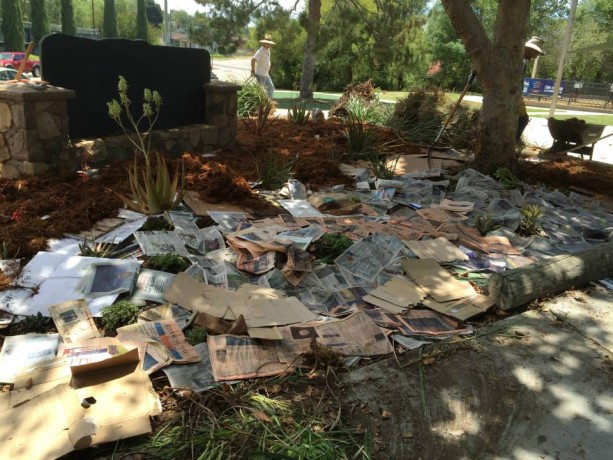
Therefore the cardboard layer wasn’t thick. We also spread around some of the branches and leaves from plants we’d removed and topped them with cardboard.
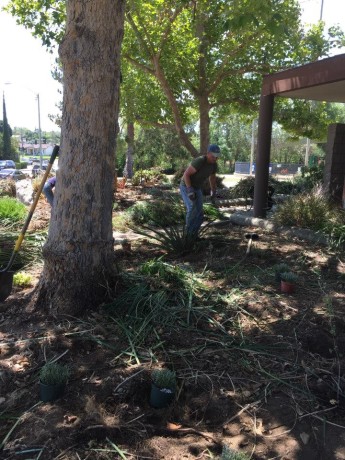
These, too, would protect the soil and decompose as great food for the worms and microbes. If the soil had been more forgiving, I would have buried a lot of the removed plants to build the soil. As it was, we were lucky to chisel out planting holes for the one-gallon plants.
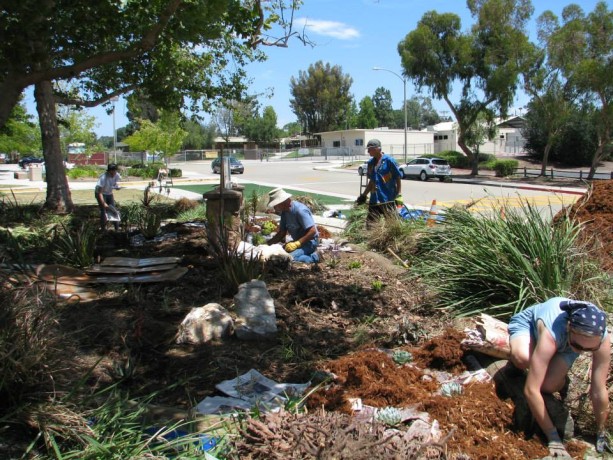
On top of the cardboard was spread gorilla hair mulch. This shredded redwood bark is excellent for use around natives and other vegetation for many reasons. It is fluffy, so it spreads much farther than wood chips and is the better value. The fluffiness also prevents it from laying firmly on the soil so it doesn’t decompose as quickly as wood chips, and most importantly it doesn’t wick moisture from the ground as do wood chips on bare soil. As gorilla hair decomposes it is a better match for our native soil composition than other mulches. It also looks great.
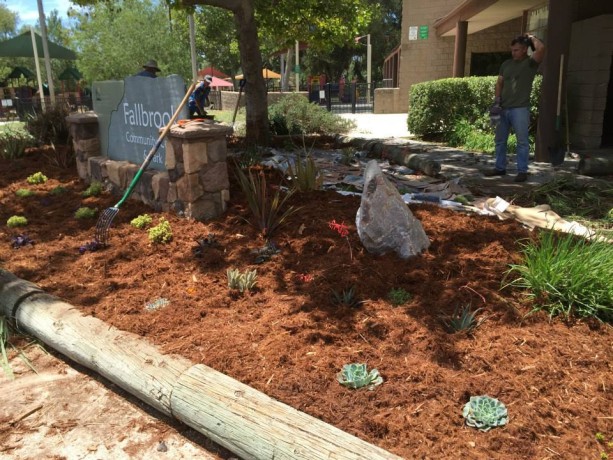
The plants were watered in around the rootball after being planted, which saved water usage tremendously. I was concerned that the surrounding dirt would wick the moisture away from the new plants, but after 5 days the root balls still had some moisture. I used a watering can and gave them all about a cup of water a week after planting. Today, after three days of triple-digit heat, I watered again and replaced a few plants that had cooked. These were my fault, having misjudged the intensity of the sun on these particular small plants. A few succulent showed signs of being stepped on as well, but overall the plants looked good.
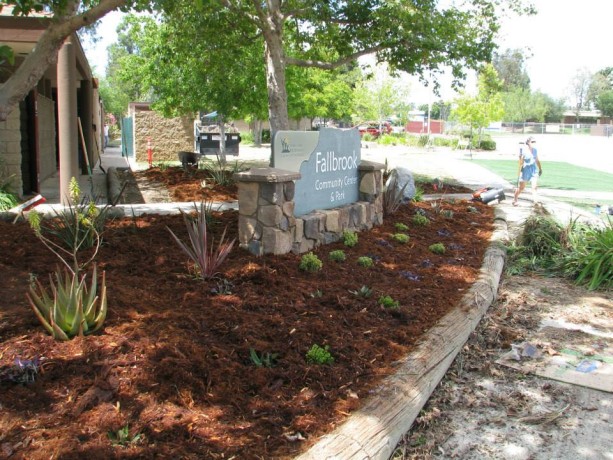
The natives and succulents were all chosen to be extremely drought tolerant and to attract birds and butterflies. Many non-native plants have very little or no habitat for animals. We’ve removed their food and shelter and replaced them with plants that need far too much water and don’t provide nourishment or adequate nesting areas. The succulents installed will feed hummingbirds and insects, as well as the other natives which will also provide food for other birds.
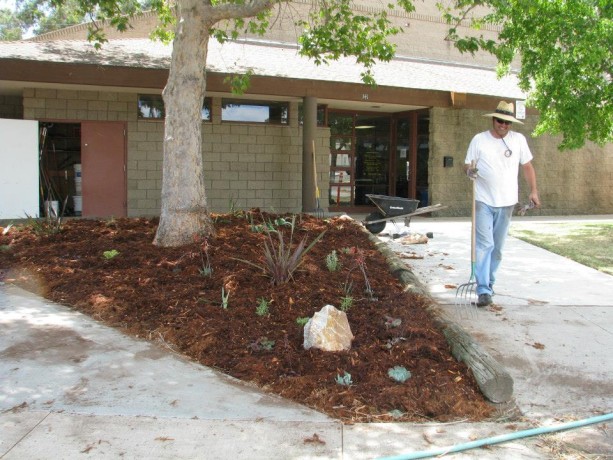
A garden should become alive with the movement of animals. Birds, butterflies, bees, lizards… they are the motion and the life of a garden. By using chemicals and only non-natives we rob these creatures of a home and adequate nourishment. By planting natives along with other plants we can share our gardens with the wildlife that so desperately need habitat.
The gorilla hair also complemented the bark of the sycamores – a happy accident. The beauty of the trees popped with the new design and mulch.
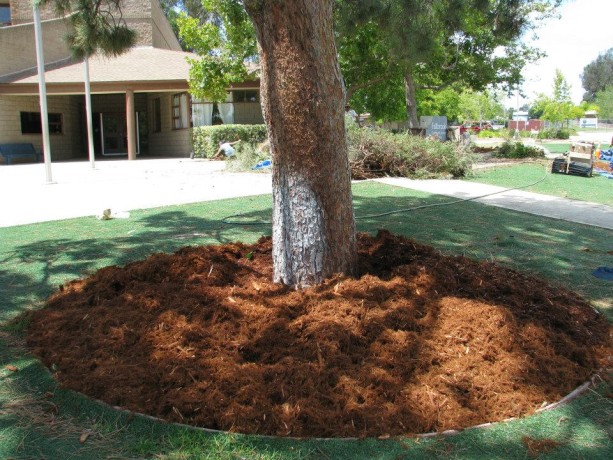
The base of the historic Christmas pine was also sheet mulched to protect the roots from more compaction and to try and help counteract a little of the damage done to it by the artificial turf that was laid some years ago.
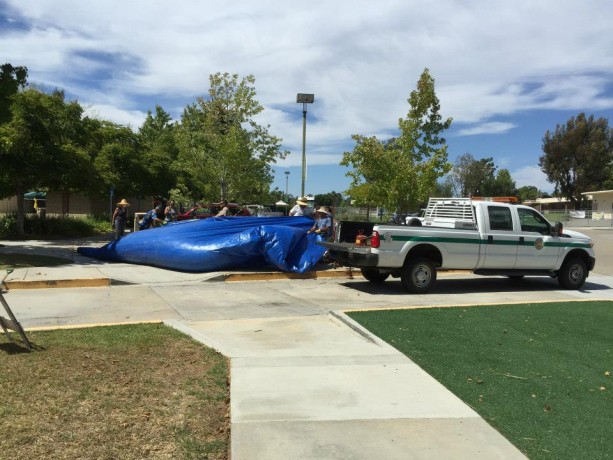
Because the gorilla hair spread farther than expected, the extra was used over cardboard in two additional planters which gave the front of the center a uniform look. I could almost hear the plants sighing in relief.
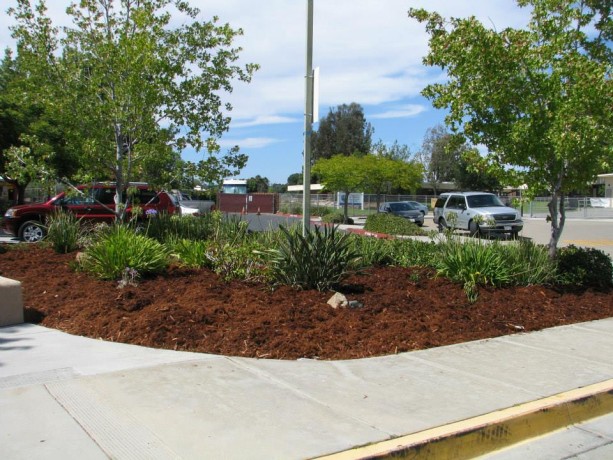
I was very fortunate to have been involved in this project, as it demonstrates permaculture techniques to the public and is in a very visual position in our community. It is also in a County facility, so perhaps other facilities will begin implementing permaculture practices to save water and build soil throughout San Diego.
This project was a long, hard job and if not for the dedication and affection of my friends and daughter it most certainly would not have come to fruition. There were many sore muscles the day after. Thanks to District Park Manger Jake Enriquez for okaying the project, Ann Wade for initiating the scheme and working with great spirits from start to finish (and providing frozen yogurt at break time!), Bill, McKenna and Grace Wade, Miranda Kennedy for sticking with her mom with every new ‘project’ that turns out to be long hours of hard labor, Bob Lloyd of PuraVida Aquatics who drove from Ramona to work hard in the sun, Susan, Jackson and Jake Liebes and Gary Beeler of the Fallbrook Land Conservancy’s Native Plant Restoration Team, Lynne, Dorothy and Barbara who are fellow students of Ann’s, wonderful friends of mine and who won some tough battles with reluctant plants, and Johanna, the FCC leader, and the staff of Live Oak Park who came in at the end for the grand finale. You all are wonderful people, and thank you for helping bring permaculture to a public facility!
